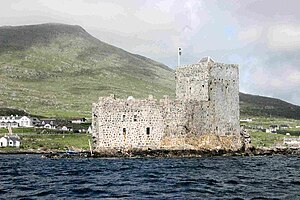Kisimul Castle
| Kisimul Castle | |
|---|---|
| Part of Barra, Western Isles | |
| Castlebay, Scotland | |
 The walls and tower of the castle seen from the bay. | |
| Type | Rectangular castle |
| Height | 11 metres (36 ft) |
| Site information | |
| Owner | Clan MacNeil |
| Controlled by | Historic Scotland |
| Open to the public | Yes |
| Condition | Partially restored |
| Site history | |
| In use | 19th century |
| Materials | Granite |
Kisimul (also Kiessimul or Chisimul) Castle is a small medieval castle located in the centre of Castlebay on Barra, an island of the Outer Hebrides, Scotland.
The earliest documentary record of Kisimul Castle dates from the mid 16th century.[1] The castle is completely surrounded by water and has never fallen to an enemy. The name of the castle comes from the Gaelic words cios (tax) and mul (mound).
Kisimul was abandoned in 1838 when the island was sold, and the castle's condition deteriorated. Some of its stone was used as ballast for fishing vessels, and some even ended up as paving in Glasgow. The remains of the castle, along with most of the island of Barra, were purchased by the chief of Clan MacNeill in 1937, who made efforts at restoration.
In 2001 the castle was leased by the chief of Clan MacNeil to Historic Scotland for 1000 years for the annual sum of £1 and a bottle of whisky.
Archaeological survey
Archaeological investigations were carried out at Kisimul Castle by Headland Archaeology, on behalf of Historic Scotland [2]. This involved some excavation, building recording and archival research. It was hoped that the project would help clarify the date of the castle and its sequence of construction. Another aim was to establish whether or not the island had been occupied before construction of the castle.
Excavation concentrated on areas of the courtyard, the basement of the tower and the bottom of a pit prison. At the east end of the courtyard there was a great deal of building rubble directly below the surface, some of which had mortar attached. This suggested that an earlier building had been demolished or collapsed, and the stone used to form a level courtyard. This happened before the building known as the kitchen was built. At the other end of the site a stone drain leading under the great hall was uncovered together with a paved stone surface. Above these was a layer containing large amounts of animal bone, shell and pottery. There were also floor surfaces within buildings that had been demolished.
During the excavation many finds were recovered. These included large quantities of animal bone and shell. Further study of these will allow us to discover more about the diet of those who lived in the castle. A large quantity of broken pottery was also found and appears to range in date from prehistoric times through the medieval period to the more recent past. A number of pieces of flint were recovered including a particularly fine flint blade. These tools together with some of the pottery show that people were using the island thousands of years before the present castle was built.
The most exciting find was recovered from one of the trenches dug within the tower. It is a fine, small gold object, shown here and in almost perfect condition. This is being looked at by specialists to discover its age and function.
References
- ^ McDonald, R. Andrew (1997). The Kingdom of the Isles: Scotland's Western Seaboard c.1100-c.1336. East Linton, East Lothian, Scotland: Tuckwell Press. p. 236-237. ISBN 1-898-41085-2.
- ^ [1]
External links
See also
Images
-
Kisimul Castle from Barra (1997)
-
View of Castlebay from Heaval






